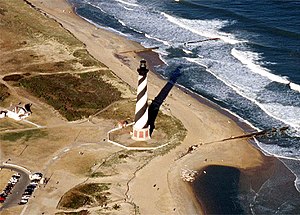Cape Hatteras


Cape Hatteras is a cape on the coast of North Carolina. It is the point that protrudes the farthest to the southeast along the northeast-to-southwest line of the Atlantic coast of North America. Two major Atlantic currents collide just off Cape Hatteras, the southerly-flowing cold water Labrador Current and the northerly-flowing warm water Florida Current (Gulf Stream), creating turbulent waters and a large expanse of shallow sandbars extending up to 14 miles offshore. These shoals are known as Diamond Shoals. Because mariners utilize ocean currents to speed their journey, many ships venture close to Cape Hatteras when traveling along the eastern seaboard, risking the perils of sailing close to the shoals amid turbulent water and the frequent storms occurring in the area. So many ships have been lost off Cape Hatteras that the area is known as the "Graveyard of the Atlantic".
The cape is actually a bend in Hatteras Island, one of the long thin barrier islands that make up the Outer Banks. The first lighthouse at the cape was built in 1803; it was replaced by the current Cape Hatteras Lighthouse in 1870, which at 198.48 feet from the ground to the tip of its lightning rod is the tallest lighthouse in the United States and the tallest brick lighthouse in the world.
In 1999, as the receding shoreline had come dangerously close to Cape Hatteras Lighthouse, the 4830-ton lighthouse was lifted and moved inland a distance of 2900 feet. Its distance from the seashore is now 1500 feet, about the same as when it was originally built.
Somewhat analogous to Point Conception in Southern California, this on-the-edge placement at the confluence of the Labrador and Florida currents leads to unusually diverse biological assemblages. Many species' ranges have either a southern or northern terminus at the cape.
Cape Hatteras is also infamous for being frequently struck by hurricanes that move up the East Coast of the United States. The strike of Hurricane Isabel in 2003 was particularly devastating for the area. Isabel devastated the entire Outer Banks and also split the two small towns of Frisco and Hatteras in half. NC 12, which provides a direct route from Nags Head to Hatteras Island, was broken in half by the hurricane. This nearly demolished the small villages of Cape Hatteras. Students had to use a ferry to get to school for almost a year. Reconstruction of the area began in 2005.
The name Hatteras is the sixth oldest surviving English place-name in the U.S. An inlet north of the cape was named "Hatrask" in 1585 by Sir Richard Grenville, the admiral leading the Roanoke Colony expedition sent by Sir Walter Raleigh. It was later applied to the island and cape as well, and modified to "Hatteras." [1]
In April 1991, mass murderer Peter Lundin killed his mother and buried her at Cape Hatteras, where her body was found eight months later[2].
References
- ^ Stewart, George (1945). Names on the Land: A Historical Account of Place-Naming in the United States. New York: Random House. p. 23.
- ^ "Lundin: Morderen der vidste at ligene sladrer" (in Danish). TV 2. 2007-09-06. Retrieved 2009-03-09.
{{cite news}}: Check date values in:|date=(help)
